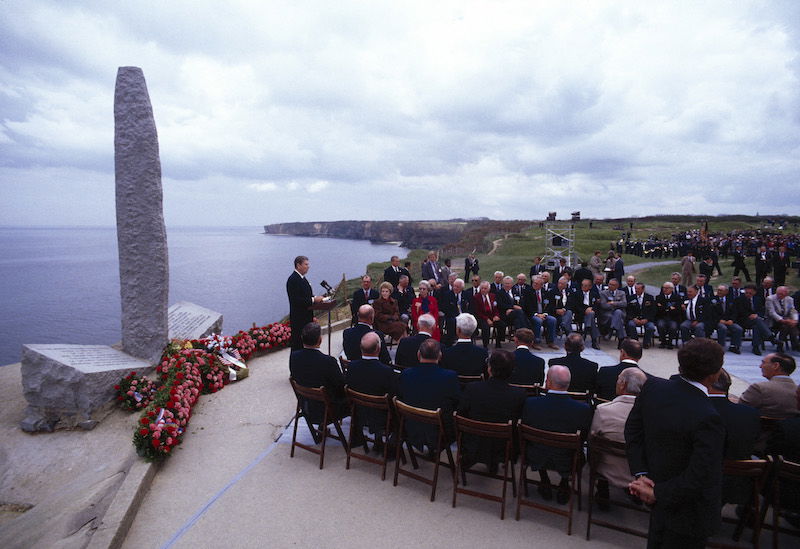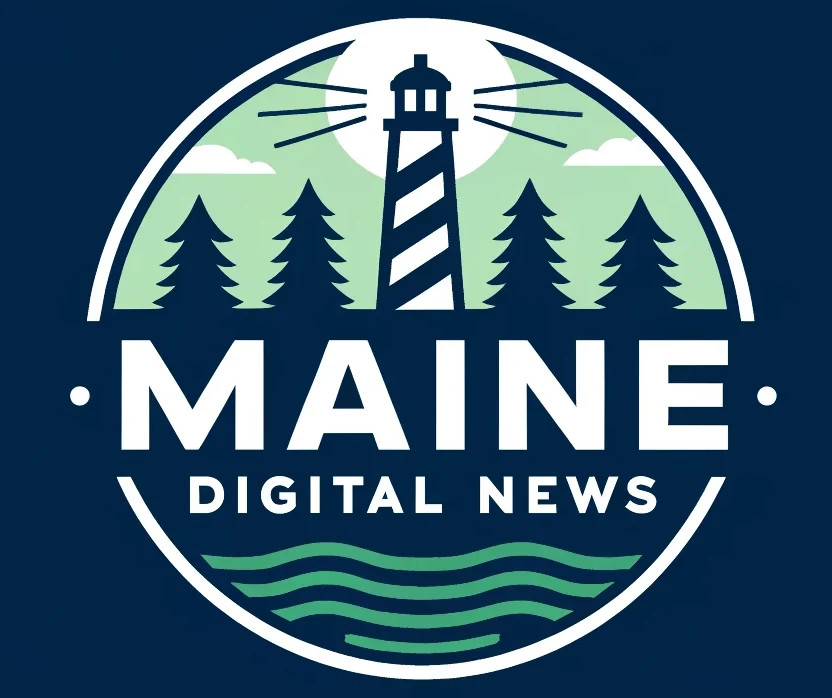On 6 June 1984 American audiences watched Ronald Reagan deliver his address on the 40th anniversary of D-Day in Normandy. Speaking at Pointe du Hoc, the promontory around three miles west of Omaha Beach captured by American troops on 8 June 1944, the speech was part of a carefully choreographed ten-day tour of Europe designed to showcase Reagan at his most ‘presidential’ in a bid to boost his re-election chances ahead of that year’s vote. It was also an opportunity to upstage his would-be Democratic rivals Walter Mondale and Gary Hart, then embroiled in an increasingly ugly battle for their party’s nomination. As CBS reporter Lesley Stahl observed at the time: ‘When it comes to political one-upmanship, Ronald Reagan is a master. Upstage the winner of the California primary – piece of cake: have lunch at Buckingham Palace with the Queen of England.’
Reagan toured Europe from 1-10 June. His first stop was Ireland where a series of photo opportunities allowed him to ostentatiously embrace his Irish heritage. Some 40 million Americans claimed Irish ancestry; it was no secret that Reagan was keen to secure their votes, as well as those of Catholic Americans, another large voting bloc. The Reagan-Bush ’84 campaign openly targeted Irish Americans, though it maintained that the timing of Reagan’s visit to Ireland was purely coincidental. The main event of Reagan’s Irish trip was a visit to his ancestral home, Ballyporeen. He visited the church where his great-grandfather’s baptism was recorded and addressed the crowds, emotionally, with a few words in Irish Gaelic. The White House secured the headlines it sought: ‘Reagan Basks in Ancestral Ballyporeen’ proclaimed the Washington Post, while the cover of the Los Angeles Times showed a banner reading ‘Welcome Home to Ballyporeen, Mr President’ and a photograph of Ronald and Nancy cheerfully enjoying a drink in the local pub.
Beyond sentimental grandstanding, Reagan’s Ireland trip allowed him to play politics, too. On 4 June he used his address to the Irish parliament to outline American commitment to European security and to restate America’s willingness to resume negotiations with the Soviet Union. He claimed that it was the Soviet Union that had ‘quit the bargaining table’ and stressed that the US was waiting to welcome them to resume negotiations. Reagan had been polling poorly on foreign policy issues at home, his staunch anti-communist stance a cause for concern among voters, with Gallup polls indicating that around 46 per cent of those polled supported his handling of the Soviet Union while only 36 per cent supported his foreign policy as a whole. Keen to appeal to moderate voters who were concerned by the hard-line stance taken earlier in his administration, Reagan’s Irish address resulted in significant media attention, including headlines such as ‘Reagan Bids for New Soviet Talks’ (New York Times), ‘A New Offer to Moscow’ (Los Angeles Times) and ‘Reagan: US Flexible on Missiles’ (Washington Post). Robert C. Rowland and John M. Jones’ study of Reagan’s presidential radio addresses has demonstrated that his tone towards the Soviet Union grew more conciliatory throughout 1984, before becoming firmer after the election was won. He was aware of the public’s dissatisfaction with the severity of his anti-Soviet rhetoric.
Reagan’s next stop was Normandy to coincide with the 40th anniversary of the D-Day landings. The administration was so confident that this speech would be a success that they deliberately timed it to take place at the same time as US breakfast news coverage. The original schedule for Reagan’s arrival in France included a greeting with President François Mitterrand before heading to Pointe du Hoc, where Reagan would deliver the first of his two speeches at around 4pm local time. This, however, would have delayed the president’s remarks to the point that they would not be seen on breakfast news in the US. The White House insisted that Reagan’s schedule be revised to allow him to speak three hours earlier at 7am EST, 1pm local time.

There was significant interest in the D-Day anniversary in the US, with NBC, CBS and ABC all showing primetime programmes. Reagan’s French trip offered a good opportunity for the president to participate in a non-partisan ceremony that made headlines in every major national newspaper. Footage of Reagan’s Normandy address was later broadcast at the Republican National Convention. His dignified remarks, combined with the presence of 62 American veterans who had participated in the landings, were lauded at home and abroad.
The front page of the New York Times on 7 June 1984 displayed a photo of Reagan standing alongside an array of presidents, prime ministers and monarchs, with the headline: ‘Reagan Honors D-Day; Calls for Spirit of Peace.’ Another headline on the same page read ‘Mondale Asserts Nomination is His; Hart not Giving In’, juxtaposing Reagan’s triumph with Democrat disunity.
The final stop was London for the G7 Economic Summit. As now, the state of the US economy in any given election year could have major repercussions for the shape of the candidates’ campaigns. Previously classified material held by the Margaret Thatcher Foundation Archive illuminates the extent to which the forthcoming election shaped Reagan’s contributions at the summit. Oliver Wright, UK Ambassador to the US, sent a series of telegrams to the Foreign and Commonwealth Office to assist in planning the G7 which reveal the White House’s priorities for the trip. His memo from 1 June 1984 states:
What the president wants above all from his visit to London is an outcome that will play well in his election campaign. His staff tell us that he will want to look ‘presidential’.
Reagan spent far less time in front of cameras in London than he did in Ireland and Normandy. However, a summit that celebrated American economic recovery was a valuable addition to his pre-election tour and coverage of the G7 was broadly positive. In Wright’s correspondence with Downing Street he observed that Reagan had been portrayed as ‘speaking for America’ while the Democrats were ‘playing politics’ – just as the White House had hoped.
Writing in the Washington Post upon Reagan’s return to the US, journalist Lou Cannon declared that: ‘No president since John F. Kennedy has performed as successfully on the world stage.’ Cannon claimed that the leaders Reagan met on his trip now treat him as a legitimate leader rather than an aging ideological aberration’. Steven Weisman, another journalist, stated that combined with trips to China and South Korea earlier in the year Reagan had ‘come of age as a statesman’. The New York Times described him as ‘a President who displayed immense self-confidence and seemingly unlimited ability to exploit the symbolism of his office’. As the election in November later that year confirmed, no challenger could compete with an incumbent enjoying the world stage and thriving in his role as ‘the Great Communicator’.
Sarah Thomson is a curator and freelance writer based in Edinburgh.





